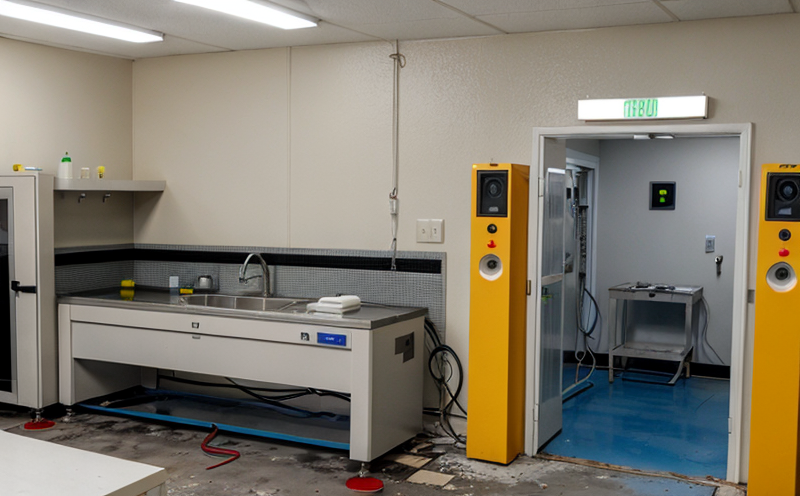ASTM C1410 Gross Alpha/Beta Contamination Monitoring of Waste
The ASTM C1410 standard provides a comprehensive approach to monitoring gross alpha/beta contamination in radioactive waste. This service is crucial for ensuring that radioactive materials are properly managed and disposed of according to regulatory standards, thereby protecting human health and the environment.
Radiological contamination testing involves the measurement of alpha and beta radiation emissions from waste materials. Alpha particles have a short range but high energy, while beta particles can travel further through matter. Both types of radiation can be harmful if not properly contained or monitored. ASTM C1410 specifies the procedures for determining gross alpha/beta activity concentrations in radioactive waste.
The testing process typically begins with sampling the waste material. The samples are then prepared according to the standard's instructions, ensuring that they represent a true cross-section of the waste being tested. After preparation, the samples undergo analysis using specialized equipment designed to detect and quantify alpha and beta radiation emissions.
ASTM C1410 emphasizes the importance of accurate measurement techniques to ensure reliable results. The standard outlines methods for both manual counting and automated detection systems. Manual counting involves placing the sample in a suitable container and observing it under specific conditions, while automated systems use sophisticated detectors capable of rapid and precise measurements.
The acceptance criteria defined by ASTM C1410 are essential for determining whether the waste meets regulatory standards. Waste must have gross alpha activity concentrations below specified limits to be considered safe for certain applications or disposal methods. Beta activity concentrations also follow similar guidelines, ensuring that all contaminated materials are handled appropriately.
Quality managers and compliance officers can benefit greatly from this service by verifying adherence to strict regulatory requirements. R&D engineers might use these test results to optimize waste treatment processes, while procurement professionals could leverage them when selecting suppliers or partners involved in radioactive material handling.
| Sample Preparation | Analytical Techniques | Acceptance Criteria |
|---|---|---|
| Follow ASTM C1410 guidelines for sampling and preparation. | Use appropriate counting equipment or automated detection systems as specified in the standard. | Ensure gross alpha activity concentrations are below regulatory limits; beta activity concentrations should also comply with set standards. |
The ASTM C1410 Gross Alpha/Beta Contamination Monitoring of Waste service plays a vital role in maintaining safety and compliance across various sectors dealing with radioactive materials. By adhering to this standard, laboratories can provide accurate and reliable test results that are essential for effective waste management practices.
Scope and Methodology
The ASTM C1410 Gross Alpha/Beta Contamination Monitoring of Waste service encompasses a detailed methodology aimed at ensuring precise and consistent measurement of radioactive contamination in waste materials. This approach ensures that all samples are handled and analyzed according to recognized best practices.
The scope includes the entire process from sample collection through final analysis. Samples must be collected using techniques that minimize contamination, which could lead to inaccurate results. Once collected, the samples undergo rigorous preparation steps outlined in ASTM C1410. These steps ensure that each sample accurately reflects the overall composition of the waste being tested.
The analytical techniques employed are designed to detect and quantify both alpha and beta radiation emissions. Manual counting methods involve placing the prepared samples into specially designed containers and observing them under controlled conditions until decay rates stabilize. Automated systems, on the other hand, utilize advanced detectors capable of providing rapid and precise measurements.
Acceptance criteria play a critical role in determining whether waste meets regulatory standards for safe handling or disposal. Alpha activity concentrations must fall below specified limits to be considered non-hazardous according to ASTM C1410 guidelines. Similarly, beta activity concentrations should comply with established thresholds set forth by the standard.
By adhering strictly to these procedures and criteria, laboratories can ensure accurate and reliable test results that are essential for effective waste management practices across multiple industries involved in radioactive material handling.
Eurolab Advantages
EuroLab brings unique advantages when it comes to providing ASTM C1410 Gross Alpha/Beta Contamination Monitoring of Waste services. Our team of experts is committed to delivering high-quality results that meet or exceed industry standards.
- Our experienced technicians understand the intricacies of each step involved in ASTM C1410 testing, ensuring accurate and consistent outcomes.
- We employ state-of-the-art analytical equipment capable of detecting even trace levels of alpha and beta emissions, providing precise measurements essential for regulatory compliance.
- EuroLab adheres strictly to all relevant international standards such as ISO 17025 and ASTM C1410, ensuring our methods are consistent with global best practices.
- Our comprehensive approach includes not only testing but also offering expert advice on waste management strategies based on the results obtained from our analyses.
By choosing EuroLab for your ASTM C1410 Gross Alpha/Beta Contamination Monitoring of Waste needs, you gain access to unparalleled expertise and technology. Our commitment to quality control ensures that every project receives personalized attention tailored specifically to its unique requirements.





